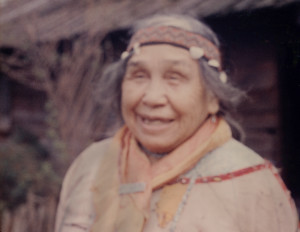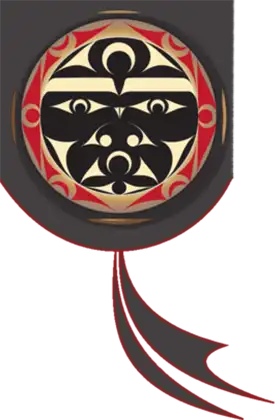səswix̌ab
Martha Williams Lamont

Photo courtesy of Tulalip Lushootseed Department.
Martha Williams Lamont
c. 1880-1973
səswix̌ab Martha Williams Lamont
Although for us today Martha is known as a person who devoted herself to preserving treasures from the past, during her life she welcomed and supported
important changes.1 During the 1930s, tribal leader William Shelton and his family conducted an outreach program designed to make the people of Tulalip better known to the non-reservation world. Many tribal people at Tulalip disapproved of this innovative work, but we have photographs that show Martha standing with the Shelton’s, beating the drum and singing to support their efforts. She endorsed these occasions further by wearing her special white dress decorated with shells. (We see a later version of the dress in the photograph above.)
Martha was an active member of the 1910 Shaker Church. Her grandson Hank Williams tells us: “She always knew when somebody needed prayer. She would be sitting there talking and pretty soon, ‘Somebody needs a prayer; I have to pray for somebody.’ So she would get that message, just out of nowhere she would say that. She was a very strong religious woman.” Martha was appointed an assistant minister of the Tulalip church and continued to serve until she became bedridden in the last decade of her life.
Perhaps because she never learned to read or write, Martha was an enthusiastic participant in projects to tape-record traditional teachings. She spent extended periods ten years apart working with different collectors, to whom she told some of the same stories. Thus, her legacy gives us a rare chance to investigate change and stability in the syəhub tradition. Martha’s tellings of “Crow and Her Seagull Slaves” ten years apart are very different. Both are funny, but in the later telling Martha uses humor to convey her feelings about the loss of tribal lands and the consequent devaluing of Native identity. To hear this second telling is to realize that these issues are latent in the first telling and would have been perceived by her Tulalip audience even without the enhancement they received later. For several decades the “Totem Entrance” stood across a road leading to the tribal center. The Entrance was composed of two figured posts, one on either side of the road; atop the posts and spanning the road is a canoe that carries a girl and two slaves. The Totem Entrance represents yet another telling of the “Crow and Her Seagull Slaves” tradition, though without Crow or seagulls. When we take account of the fact that both of Martha’s tellings are parodic realizations of the version on the Totem Entrance, we see that all three variants are anchored in a tradition that as yet bears only the names of its separate tellings. In her enthusiasm for the new recording technology, Martha has enabled us to travel more deeply into our heritage than we could have imagined.
The Totem Entrance represents yet another telling of the “Crow and Her Seagull Slaves” tradition, though without Crow or seagulls. When we take account of the fact that both of Martha’s tellings are parodic realizations of the version on the Totem Entrance, we see that all three variants are anchored in a tradition that as yet bears only the names of its separate tellings. In her enthusiasm for the new recording technology, Martha has enabled us to travel more deeply into our heritage than we could have imagined.
1This introductions combines the memories of Hank and Geraldine Williams, the late Vi taqʷšəblu Hilbert, the late Thom Hess the late Marya Moses, and Wayne Williams.
Some of səswix̌ab Martha Williams Lamont’s stories
The Seal Hunter Brother’s
Pheasant and Raven
Crow and Her Seagull Slaves
